Dr. Ruben Puentedura developed the SAMR Model to classify various levels of technology used in the classroom.
The SAMR model technology was developed so that educators from different fields could speak the same language in their pursuit of personalized education and the visualization of abstract ideas for their students. In a hybrid learning environment, the SAMR Model may prove to be a valuable tool for maximizing the effectiveness of integrated classrooms.
What is the SAMR Model?

What is SAMR? The SAMR Model categorizes online education into four different phases or tiers: “Substitution,” “Augmentation,” “Modification,” and “Redefinition.” Most educators who make the transition to virtual learning focus solely on the first 2 phases, which involve substituting conventional materials with digital versions, such as creating PDFs of lessons and homework assignments and providing students with online or pre-recorded lectures for asynchronous learning.
Let’s talk about each phase in detail:
Substitution

Technology acts as a direct substitute, with no functional change
This is the fundamental stage of SAMR model technology, in which EdTech is adapted to serve as a replacement for more conventional methods. While the content of the class does not change, the way that content is delivered changes. Substitution methods allow teachers to free up valuable time and space by replacing paper-based tasks with digital alternatives. In comparison to printing everything out and stuffing it in a drawer, digitizing class materials is a more efficient approach to keeping track of data and managing resources.
Learning by substitution is a far more accessible method of gaining technical soft skills than learning through modification and redefinition. It’s important for kids to get familiar with new technologies before teachers start incorporating them into classroom training. Essentially, this involves swapping analog components with digital ones, without affecting the device’s functionality.
For example:
- Rather than jotting down notes in their notebook, students can type their notes on word processing software (like Google Docs or Microsoft Word).
- To save time and effort, quizzes and exams can be taken digitally instead of on paper.
- A regular whiteboard can be substituted with a digital whiteboard, which can help students and teachers in sharing class notes, saving files, recording lessons, etc.
Augmentation

Technology acts as a direct substitute, with functional improvement
In the augmented phase, technology contributes to education beyond the obvious ways. Building off the substitution phase, class content stays the same but is delivered in a new way so that students can take better advantage of newer digital features in their lessons. Augmentation might help your students better understand a difficult subject, or make it more interesting to them than more conventional teaching approaches.
Moreover, it paves the way for an education method that is student-oriented. Kids can jump right into studying with the help of technology.
For example:
- A PowerPoint with multimedia features helps students offer more insightful and interesting presentations.
- Instead of depending on teacher guidance, students do their own research online.
- To increase interest in and retention of course material, as well as to provide a transparent means of monitoring student progress, teachers and students can both use an ed-tech platform that uses game-based learning to deliver course content.
- Tools such as a video are used to help teachers convey a complex topic to their students.
Modification

Technology allows for significant task redesign
As part of the SAMR model’s transformation phase, modification entails rethinking the lesson plan in question. Most modern classrooms have adopted the use of a learning management system (LMS) to streamline the process of assigning, collecting, grading, and providing feedback on student work.
At this point, SAMR has progressed beyond the “enhancement” phase and into the “transformation” phase. Here, technology is used to change a student’s mindset and problem-solving strategies, both inside and outside of the classroom.
The Modification Phase can also help students team up with each other.
For example:
- Students use Google Docs to draft research reports and share them with their classmates, discussing the assignment in the Comments section.
- Students hand in their assignments using Google Classroom, and educators provide evaluations using the platform’s built-in rubric.
Redefinition

Technology allows for the creation of new tasks, previously inconceivable
The final stage of SAMR model technology is redefinition, where innovative learning practices are developed through the use of technology. The last step is a model of how student learning can be transformed via the use of modern, interconnected technologies. At this stage, students use technology in unusual ways to create challenging academic tasks that would not exist normally.
Learning may be revamped to better connect with the real world and provide genuine results. It also helps students develop “technical soft skills,” such as communication, teamwork, and adaptability in a digital environment. It also entails making innovative use of technology in the classroom to help students develop a growth mindset so that they can succeed and become actively involved in their education.
For example:
- Students can connect with people from across the globe and contribute to a better learning environment.
- It may be quite beneficial to record students when they deliver a presentation or perform physical activity, and then use the recording to encourage them to reflect on their performance.
SAMR Model Examples

Here are some examples of a SAMR model:
- Writing a paper on World War II history
Students can choose from the following writing strategies within the SAMR framework:
- Substitution: Using a computer program, such as Microsoft Word, in place of traditional methods
- Augmentation: Using programs like Microsoft Word, as well as text-to-speech and grammatical checking, to enhance the quality of students’ work.
- Modification: Using software like Microsoft Word and similar tools, followed by online sharing for the purposes of receiving comments and enhancing the paper’s overall quality.
- Redefinition: Using digital media like video and animation editors to communicate the same ideas that would normally be expressed in a written assignment.
- Assessment
Transforming a simple quiz into a collaborative project:
- Substitution: Use a Word Processor file to deliver the quiz and have students complete it digitally.
- Augmentation: Deliver and grade the test through a Google Form.
- Modification: Instead of taking a multiple-choice test, students could be given a topic and instructed to write an essay on it. The essay could then be read aloud and recorded as audio.
- Redefinition: Having a classroom make a documentary film in which they address a major question about a core subject. Students work in groups to tackle different aspects of a larger project.
- Painting and Art Lesson
To create a piece of artwork:
- Substitution: Use online drawing/painting software to draw/paint a picture.
- Augmentation: Use a tool that allows you to create your art in new dynamic ways.
- Modification: Take a picture to use as a canvas. Even a hand-drawn image scan might be used.
- Redefinition: Create real-time visuals as a group using a shared digital whiteboard
- Proper Email Etiquette
To analyze printed copies of email etiquette
- Substitution: Have students read a short article online that introduces key principles and standards for proper email etiquette.
- Augmentation: Comment on the article and highlight five favorite tips.
- Modification: Share their five tips on social media.
- Redefinition: Evaluate real-world instances of poor email etiquette and choose the appropriate guidelines to apply in order to make the situations more suitable.
What are the Benefits of the SAMR Model?

The SAMR approach has several advantages, the majority of which are related to our ability to analyze and improve the ways in which we use technology in our teaching. The SAMR framework encourages us to reevaluate our teaching practices and consider new ways to use technology to maximize student learning.
Because of this, rather than using the SAMR model to create lessons and curricula, educators may find it most useful to utilize the model as a framework for reflecting on how technology is utilized in the classroom.
The SAMR model also gives us a common understanding to discuss how we can best incorporate technology into our teaching and classrooms.
Integrating the SAMR Model in Your Classroom

It’s possible that in the future, SAMR will be a crucial foundation for preparing lessons. Knowing what can be done with technology and how it can help your class puts you in a much better position to teach.
Keep in mind that, although SAMR may seem like a challenging summit to scale, it is, in fact, similar to a set of tools. It’s all about using the right one.
Update Your Classroom With Vibe

The Vibe interactive whiteboard is an all-in-one teaching tool built for innovative classrooms and engaging lessons.
For distance learning, hybrid classrooms, and in-person lessons, the Vibe Board is perfect for taking your classroom to the next level with an infinite virtual whiteboard, perfect for class notes, presentations, streaming, and so much more.
Discover how a Vibe Board can transform your classroom here.
{{< blog/cta-download-new content=”Future of Learning” extra=”false” pdf=”https://vibe.us/pdf/future-of-hybrid-learning/?utm_campaign=samr-model&utm_medium=blog&utm_source=blog“>}}
FAQs
What is SAMR used for?
The SAMR model is basically a planning tool that is used to assist in the development of outstanding educational experiences for students. The framework gives educational input into how technology can and should be utilized in the classroom.
How do you integrate technology into the classroom?
- Engaging in a game-based educational environment
- Methods of using technology and differentiated instruction to create lesson plans
- Create a website for your class
- Use social media as a part of your teaching process
What are the levels of SAMR?
There are four levels of SAMR:
- Substitution: Using technology as a substitute, with no functional improvements
- Augmentation: Adding functional improvements
- Modification: Necessary task redesign
- Redefinition: Creation of task normally impossible
